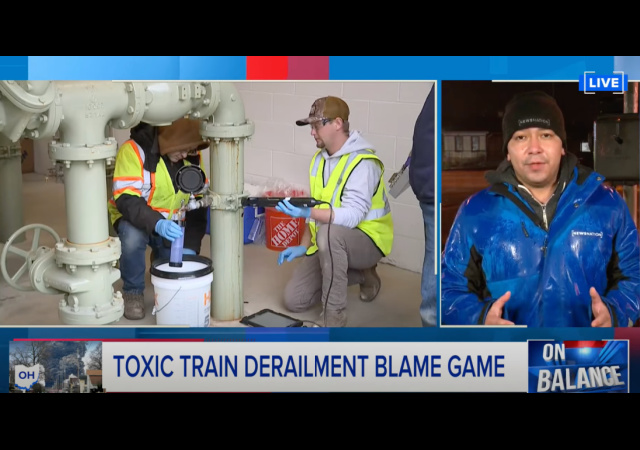Nine Chemical Readings From Ohio Train Disaster ‘are Higher Than Normal’

But I thought everything was okay? The EPA said its chemical readings are normal!
Scientists from Texas A&M and Carnegie Mellon universities found that nine of the 12 chemicals from the East Palestine, OH, train disaster are reading higher than normal.
EPA Administrator Michael Regan is headed to Ohio for his third visit to open a center where residents can visit government officials.
It looks like residents will already have a lot to bring up with Regan and others. From CNN:
If the levels of some of these chemicals remain high, it could be a problem for residents’ health in the long term, the scientists say. Temperature changes or high winds might stir up the chemicals and release them into the atmosphere.The highest levels found in East Palestine were of a chemical called acrolein, the analysis says.Acrolein is used to control plants, algae, rodents and microorganisms. It is a clear liquid at room temperature, and it is toxic. It can cause inflammation and irritation of the skin, respiratory tract and mucous membranes, according to the US Centers for Disease Control and Prevention.“It’s not elevated to the point where it’s necessarily like an immediate ‘evacuate the building’ health concern,” said Dr. Albert Presto, an associate research professor of mechanical engineering at Carnegie Mellon’s Wilton E. Scott Institute for Energy Innovation, who is working on the university’s chemical monitoring effort in East Palestine. “But, you know, we don’t know necessarily what the long-term risk is or how long that concentration that causes that risk will persist.”
This is awful. The EPA told CNN the readings “are below levels of concern for adverse health impacts from short-term exposures.”
Residents have reported experiencing rashes, illnesses, and other health problems.
It’s not an easy situation. One scientist said government officials need to provide details when they say everything is safe in East Palestine:
“I think it’s important for the public to understand that all sides are right. No one’s lying to them,” said Dr. Ivan Rusyn, director of the Texas A&M University Superfund Research Center and part of the team that did the analysis. “It’s just that every time you’re sharing information, whether it’s Administrator of EPA Michael Regan or Governor [Mike] DeWine or someone from Ohio EPA, when they say certain things are ‘safe,’ they really need to explain what they mean.”Rusyn says the EPA and local officials need to do a better job of communicating with the public about the risk to residents when they are exposed to chemicals released in the crash.Communication struggles have been a consistent pattern over the years and over numerous environmental disasters, he said. Officials will often do a good job of collecting and releasing data but then fail to give the proper context that the public will understand.“That’s what I would like to encourage all parties to do rather than to point fingers,” Rusyn said. “The general public has to trust authorities. Cleanup is continuing. They are doing monitoring. We just need to do a better job communicating the results.
Healthcare workers told WKBN the ailments they see in people, including chemical bronchitis:
Some even complain they start feeling better when they leave their homes for a while, only to feel worse once they return.“This could be a lot of things, but if you’re leaving your house and [symptoms] improve, and you go back and it comes back, I’m not thinking that’s allergies or not thinking it’s a cold,” said Deb Weese with QUICKmed. “I think it’s related to that stuff you’re inhaling there.”Weese says the burning sensation when breathing could be what she calls a form of chemical bronchitis. She urges anyone suffering similar symptoms to seek treatment.“Let’s face it: If it comes down to it, it might be something in the future that comes about from all these chemicals they’re breathing in that we don’t know about, so it’s important that they document all of their symptoms,” Weese said.
Concerns have sparked in areas where the EPA is disposing the toxic waste.
The EPA paused shipments to Texas after politicians protested the idea of disposing of waste in Houston:
Trucks were carrying toxic wastewater more than 1,300 miles from eastern Ohio to inject it underground at the Texas Molecular facility in Deer Park, on the edge of Greater Houston, the nation’s fifth-largest metro area.Officials issued statements saying the public should have been warned, prompting the Environmental Protection Agency on Saturday to order a halt to shipments of waste out of the Ohio disaster site, where a train carrying toxic chemicals derailed and caught fire earlier this month.
The EPA is also sending waste to an Indiana landfill. Gov. Eric Holcomb objects to the disposal, especially since federal officials haven’t spoken much to Indiana officials:
“I continue to object to the EPA Administrator’s decision, from Washington, D.C., to move hazardous waste from the East Palestine train derailment to Indiana. Further, there has been a lack of communication with me and other Indiana officials about this decision.”After learning third-hand that materials may be transported to our state yesterday, I directed my environmental director to reach out to the agency. The materials should go to the nearest facilities, not moved from the far eastern side of Ohio to the far western side of Indiana. I have made a request to speak to the administrator to discuss this matter. I want to know exactly what precautions will be taken in the transport and disposition of the materials.”
CLICK HERE FOR FULL VERSION OF THIS STORY